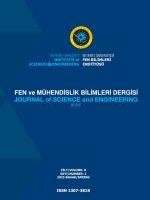TEDARİK ZİNCİRİ YÖNETİMİNDE KULLANILAN ÇEVİK YÖNTEMLERİN DEĞERLENDİRİLMESİNE YÖNELİK ÇKKV MODEL ÖNERİSİ VE ÇÖZÜMÜ
Tedarik Zinciri Yönetimi, Çevik Yönetim, Çevik Tedarik Zinciri, SWARA, WASPAS
A MCDM MODEL PROPOSAL AND SOLUTION FOR EVALUATING AGILE METHODS USED IN SUPPLY CHAIN MANAGEMENT
Supply Chain Management, Agile Management, Agile Supply Chain, SWARA, WASPAS,
___
- Ciccullo, F., Pero, M., Caridi, M., Gosling, J., & Purvis, L. (2018). Integrating the environmental and social sustainability pillars into the lean and agile supply chain management paradigms: A literature review and future research directions. Journal of Cleaner Production, 172, 2336–2350. http://doi.org/10.1016/j.jclepro.2017.11.176
- Loiro, C., Castro, H., Avila, P., Cruz-Cunha, M. M., Putnik, G. D., & Ferreira, L. (2019). Agile project management: A communicational workflow proposal. Procedia Computer Science, 164, 485–490. https://doi.org/10.1016/j.procs.2019.12.210
- Marnada, P., Raharjo, T., Hardian, B., & Prasetyo, A. (2022). Agile project management challenge in handling scope and change: A systematic literature review. Procedia Computer Science, 197, 290–300. https://doi.org/10.1016/j.procs.2021.12.143
- Moktadir, M. A., Dwivedi, A., Khan, N. S., Paul, S. K., Khan, S. A., Ahmed, S., & Sultana, R. (2021). Analysis of risk factors in sustainable supply chain management in an emerging economy of leather industry. Journal of Cleaner Production, 283, 124641. https://doi.org/10.1016/j.jclepro.2020.124641
- Prajapati, H., Kant, R., & Shankar, R. (2019). Prioritizing the solutions of reverse logistics implementation to mitigate its barriers: A hybrid modified SWARA and WASPAS approach. Journal of Cleaner Production, 240, 118219. https://doi.org/10.1016/j.jclepro.2019.118219
- Shashi, Centobelli, P., Cerchione, R., & Ertz, M. (2020). Agile supply chain management: where did it come from and where will it go in the era of digital transformation? Industrial Marketing Management, 90, 324–345. https://doi.org/10.1016/j.indmarman.2020.07.011
- Soltanmohammadi, A., Ardakani, D. A., Dion, P. A., & Hettiarachchi, B. D. (2021). Employing total quality practices in sustainable supply chain management. Sustainable Production and Consumption, 28, 953–968. https://doi.org/10.1016/j.spc.2021.07.013
- Taş, M. A. (2020). Selecting a green, agile and industry 4.0 supplier with the fuzzy-SWARABWM integrated method. Süleyman Demirel University, Institute of Natural and Applied Sciences, Master Thesis.
- ISSN: 1307-3818
- Başlangıç: 2007
- Yayıncı: Beykent Üniversitesi
TERSİNE LOJİSTİKTE DİJİTALLEŞMENİN KRİTİK FAKTÖRLERİ ÜZERİNE BİR ÇALIŞMA
TEDARİK ZİNCİRİ DİRENCİLİĞİNİ ARTIRMAK İÇİN DİJİTALLEŞME OLASILIKLARI VE SINIRLARI
Marc-andré WEBER, Peter D. FRANKE, Ulrike AUMUELLER
Türkiye’deki Akıllı Kargo Dolabı Uygulamaları
GERÇEK HAYAT AKTARMA PROBLEMİNE TAM ÇÖZÜM
